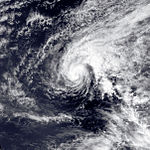1992 Pacific hurricane season
| 1992 Pacific hurricane season |

Season summary map
|
| Seasonal boundaries |
| First system formed |
January 28, 1992 |
| Last system dissipated |
November 23, 1992 |
| Strongest storm |
|
| Name |
Tina |
| • Maximum winds |
150 mph (240 km/h)
(1-minute sustained) |
| • Lowest pressure |
932 mbar (hPa; 27.52 inHg) |
| Seasonal statistics |
| Total depressions |
30 |
| Total storms |
27 (record high)
|
| Hurricanes |
16 (record high, tied with 1990, 2014 and 2015)
|
Major hurricanes
(Cat. 3+) |
10 |
| Total fatalities |
22 |
| Total damage |
$1.85 billion (1992 USD) |
| Related articles |
|
|
Pacific hurricane seasons
1990, 1991, 1992, 1993, 1994
|
| Category 3 hurricane (SSHWS) |
|
|
| Duration |
January 28 – February 3 (Exited basin)
|
| Peak intensity |
115 mph (185 km/h) (1-min) ≥982 mbar (hPa) |
| Tropical storm (SSHWS) |
|
|
| Duration |
March 28 – March 30 |
| Peak intensity |
50 mph (85 km/h) (1-min) 1005 mbar (hPa) |
| Tropical storm (SSHWS) |
|
|
| Duration |
June 1 – June 5 |
| Peak intensity |
70 mph (110 km/h) (1-min) 990 mbar (hPa) |
| Tropical storm (SSHWS) |
|
|
| Duration |
June 22 – June 24 |
| Peak intensity |
40 mph (65 km/h) (1-min) 1004 mbar (hPa) |
| Category 4 hurricane (SSHWS) |
|
|
| Duration |
June 22 – July 4 |
| Peak intensity |
145 mph (230 km/h) (1-min) 935 mbar (hPa) |
| Category 3 hurricane (SSHWS) |
|
|
| Duration |
July 2 – July 10 |
| Peak intensity |
120 mph (195 km/h) (1-min) 968 mbar (hPa) |
| Category 4 hurricane (SSHWS) |
|
|
| Duration |
July 9 – July 17 |
| Peak intensity |
140 mph (220 km/h) (1-min) 943 mbar (hPa) |
| Category 4 hurricane (SSHWS) |
|
|
| Duration |
July 13 – July 23 |
| Peak intensity |
145 mph (230 km/h) (1-min) 935 mbar (hPa) |
| Category 2 hurricane (SSHWS) |
|
|
| Duration |
July 14 – July 26 |
| Peak intensity |
110 mph (175 km/h) (1-min) 964 mbar (hPa) |
The 1992 Pacific hurricane season is the most active Pacific hurricane season on record. The most notable storm was Hurricane Iniki, which caused billions of dollars of damage to the Hawaiian Islands. Hurricanes Lester, Virgil, Winifred, and Orlene also made landfall and killed several people, but were significantly less destructive. Hurricane Darby and Tropical Storm Agatha brought rains and more destruction to Mexico, without making landfall. Hurricane Tina was the longest-lasting Pacific hurricane at the time. Also of note are Hurricane Ekeka and Tropical Storm Hali, which formed in late January and late March, respectively.
The season officially started on May 15, 1992, in the Eastern Pacific, and on June 1, 1992, in the central Pacific, and lasted until November 30, 1992. These dates conventionally delimit the period of each year when most tropical cyclones form in the northeastern and north-central Pacific Ocean. However, the season wildly exceeded these bounds, as climatological effects including an El Niño caused Hurricane Ekeka to form on January 26. It is also the only known time that multiple cyclones had formed before the season began.
During the season, twenty-seven tropical cyclones formed in the Eastern Pacific (east of longitude 140°W), and twenty-four developed further and became tropical storms. Both of these figures constitute records in the basin, as the 1992 season surpassed the season with the most tropical cyclones (1982, 26) and the season with the most named storms (1985, 22). Of these, fourteen reached hurricane strength and eight became major hurricanes—storms that reach Category 3 or higher on the Saffir-Simpson Hurricane Scale.
...
Wikipedia


















